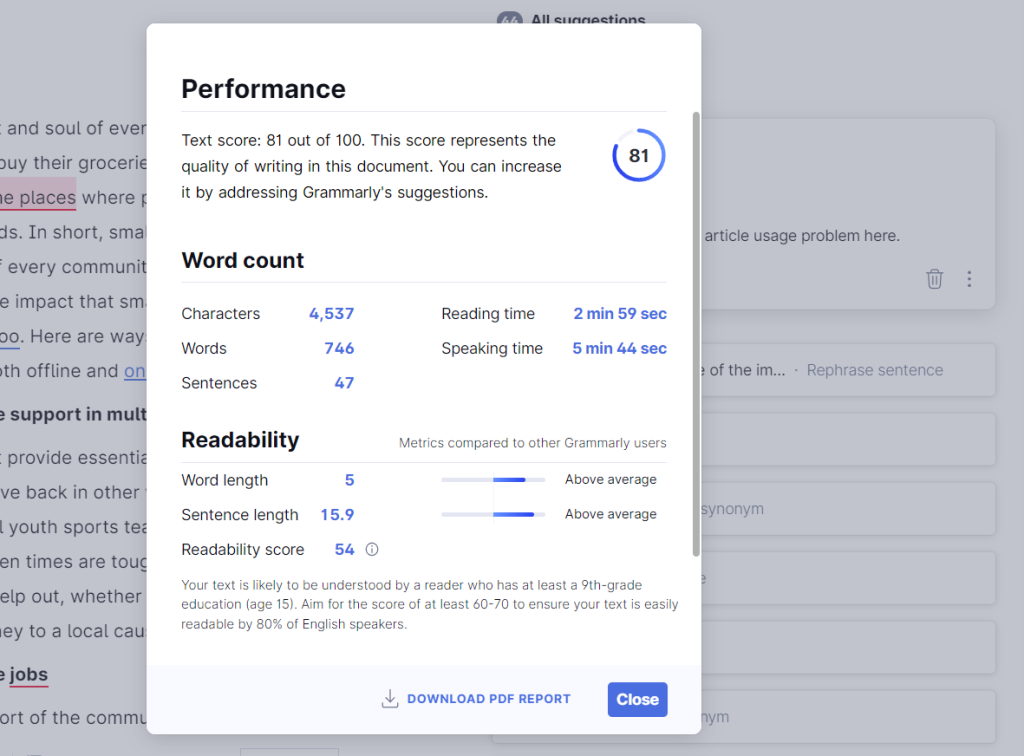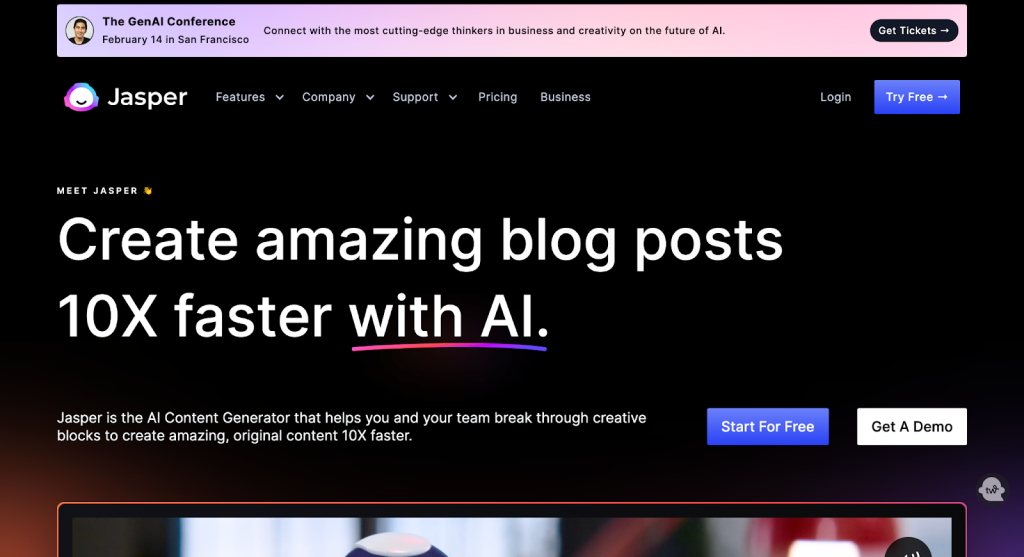AI writing has become an invaluable tool for copywriters looking to produce creative and engaging content.
Today, it’s a secret weapon for copywriters looking to up their game. With automated tools, you can quickly whip up a compelling copy in no time. Plus, the advanced semantic capabilities help you uncover hidden connections between ideas that might have gone unnoticed.
This blog post will show you how to harness the power of AI writing tools, take your copywriting to new heights, and optimize your content for maximum impact!
What Are AI Writing Tools?
AI Writing Tools are like robot wordsmiths, using natural language processing NLP to craft human-like text.
These tools can be used for various tasks, from writing content and blog posts to developing automated responses for customer service inquiries.
They help reduce the burden of checking grammar and syntax errors, assist with editing and formatting documents, and optimize content depending on the target audience.
So whether you’re whipping up a blog post, crafting customer service responses, or needing a second set of eyes on your grammar, these tools have you covered.
They’ll help in making more informed and confident decisions, increase efficiency and precision, professionally format documents, and tailor your content to your target audience, making it more effective and impactful.
They’re like having a writing assistant in your back pocket!
Benefits of leveraging AI writing tools
It’s clear that you’ll save time by using these tools, but what else can they do? Let’s take a look.
- Improved grammar and punctuation: AI writing tools help detect grammatical errors, spelling mistakes, and other issues quickly and accurately.
- Enhanced readability: Many such tools are designed to improve the readability of your writing by identifying and suggesting changes to complex sentences, passive voice, and other readability issues.
- Content creation assistance: Some of these platforms can help you generate written content based on keywords or topics you provide, which can be particularly useful for creating blog posts, social media posts, or other types of written content in a content management system.
- Copywriting Optimization: AI writing tools can analyze user data to optimize copywriting for a target audience, providing more engaging and tailored content.
- Time-saving: Using them helps save time since they can produce content much faster than a human writer.
- Creativity boost: You’ll get new ideas and different ways of expressing yourself by providing alternative words, phrases, or sentences you might not have thought of on your own.
- Consistency: Get help you maintain consistency in tone, voice, and style throughout your writing, ensuring your brand’s message is communicated consistently across all your content.
When you use these tools well, your writing will be polished, readable, and optimized for success, leaving your competitors wondering how you do it all.
How to Write a Better Copy using AI Writing tools
While AI tools will help you write faster and even better, they do have a slight learning curve.
You need to know what you want and you have to guide the platform to achieve your goals. Here’s are steps you need to take to generate powerfu copy using AI tools.
1. Preparation
Before diving into any writing project, it’s crucial to research and gather inspiration for content ideas.
By understanding your target audience, you’ll be able to choose topics and angles that genuinely resonate with them.
Efficiently gather ideas, organize research and streamline your writing process with note-taking apps for writers and mind-mapping software, which enable you to save, manage, and easily access your thoughts and sources.
Once you’ve honed in on your subject matter, break it down into manageable chunks using lists or any other organizational method that works for you. This approach ensures that each task gets the attention it deserves before moving on to the next, leading to a polished and well-structured final product.
2. Crafting the Copy
With proper research and planning in place, it’s time to begin crafting your copy using your AI tool for automation and editing.
It’ll handle tedious tasks such as sentence structure and phrasing, giving you the freedom to focus on crafting unique narratives and concepts that resonate with your target audience.
AI writing tools can be a powerful ally in ensuring that your brand’s message is communicated consistently across all your content by recognizing and maintaining the desired tone of voice. With the ability to set and maintain a specific tone of voice for AI writing, you can ensure that your message is communicated in a way that aligns with your brand’s identity and resonates with your target audience.
Finally, integrate your favorite AI tool into a comprehensive pre-publication workflow system, where editors can review each draft stage and provide feedback before it’s finalized for publication.
This ensures the highest quality of your work and guarantees that your content will be polished, error-free, and in line with your brand’s tone of voice.
One good AI tool that you can use is Jasper. It’s a premium AI writing assistant that delivers great human-sounding content.
What’s great about this tool is that you get great support, plenty of documentation and video training, and the company’s leadership are always looking for ways to improve the platform. It’s a worthwhile investment for anyone who wants to leverage automation in writing.
3. Edit Your Content
Once you’ve drafted your material, you’re ready to edit it. It’s critical to have some space between writing your post and checking if it’s done.
Waiting for a few hours or a day before you go back and read your content helps you identify mistakes faster. You’ll also see your post with fresh eyes and figure out how to improve it. It’ll be easier to spot odd phrases or unnatural sounding words.
However, you might want to use AI tools to make this process easier and faster.
For example, try Grammarly which is an AI writing assistant that helps detect grammar and spelling errors and offers suggestions to improve writing.
It can also refine your tone of voice, checks for plagiarism, and gives you a score on how readable and engaging your piece is.

Inside Grammarly – you can get a detailed report on how good your content is and ways to improve it with AI analysis.
4. Optimizing Content with AI Writing Tools
With your first draft completed, it’s time to take your content to the next level.
You can use AI to analyze your content and provide suggestions for improving it in terms of SEO, readability, and more.
For example, they can help you identify keywords to target, strengthen your meta tags, and analyze your content’s readability score.
Also, some tools can also generate content based on a specific topic or keyword, which can help create blog posts, product descriptions, and other types of written content.
Using these tools, you can ensure that your content is well-written, optimized for search engines, and accessible to your target audience.
These extra steps will make your content stand out and ensure it resonates with your target audience!
How Can I Make AI Tools Work Best For Me?
Here are more tips on how to get the most out of these powerful tools and elevate your writing game.
- Understand the Tool: Get to know the features of the AI writing tool you’re using, including its capabilities and limitations.
- Experiment with different tools: Try various platforms to find the one that best fits your needs and preferences.
- Understand the context: Make sure to provide enough context to the AI tool to understand the purpose of your writing and provide relevant suggestions.
- Set Goals: Establish clear goals for your project and decide which features of the tool you need to achieve them.
- Test & Iterate: Test the tool and make adjustments to ensure it meets your needs. Please pay attention to the feedback provided by the AI and learn from it. Doing this will help you to improve your writing over time!
- Customization: Leverage customization options such as natural language processing (NLP) and keyword optimization to further optimize content generation. Also, many AI tools have settings that can be customized to fit your preferences. Take the time to explore the settings and adjust them to your liking.
- Use them as a tool, not a replacement: These new tools are designed to assist you, not replace you. Remember to keep your voice and perspective in your writing. AI tools provide suggestions, but keeping your voice and perspective is essential. Use the suggestions as a guide, but don’t feel obligated to use them all.
- Constantly review and improve: Continuously review the suggestions provided by the tool, make sure they align with your writing goals, and try to improve your content as much as possible.
By following these tips and tricks, you’ll unlock the maximum potential of AI writing tools, transforming them to work for you rather than against you, taking your writing to new heights, and leaving your competition in the dust!
Conclusion
In today’s digital world, artificial intelligence is becoming ubiquitous in all aspects of our lives, including copywriting.
For businesses, leveraging AI writing tools in their marketing efforts is no longer a luxury but a necessity to stay competitive, increase brand recognition, and ultimately drive more qualified leads.
Not only that, but businesses can also enjoy long-term benefits such as streamlined editing processes, personalized content optimization, and measurable engagement metrics.
With AI technology advancing rapidly, integrating AI writing tools into your workflow today is just the beginning of the potential improvements you can expect to see in the future. We can only expect improved performance results when integrating AI Writing Tools within our workflows now -and far into the 2020s future!


